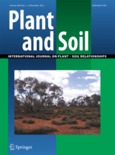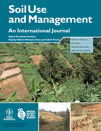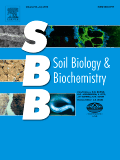
NUTRIENT CYCLING IN AGROECOSYSTEMS
Scope & Guideline
Advancing Sustainable Practices in Agroecosystems
Introduction
Aims and Scopes
- Nutrient Management Strategies:
Research on various strategies for managing nutrients in agroecosystems, including the use of organic and inorganic fertilizers, cover crops, and innovative practices to enhance nutrient use efficiency. - Soil Health and Fertility:
Investigations into the effects of different farming practices on soil health, including organic amendments, tillage practices, and their impact on soil nutrient availability and cycling. - Environmental Impact Assessments:
Studies assessing the environmental implications of nutrient management practices, including greenhouse gas emissions, water quality, and the sustainability of agricultural practices. - Circular Economy in Agriculture:
Exploration of concepts related to nutrient recycling and the circular economy, focusing on minimizing waste and maximizing resource use in agricultural systems. - Crop Production and Yield Optimization:
Research aimed at understanding the relationships between nutrient management, crop productivity, and yield optimization in various cropping systems.
Trending and Emerging
- Innovative Fertilizer Technologies:
There is a growing interest in the development and application of enhanced efficiency fertilizers, biochar, and other innovative amendments that improve nutrient use efficiency and reduce environmental impacts. - Climate Resilience and Adaptation Strategies:
Research focusing on strategies to enhance the resilience of agroecosystems to climate change, including the optimization of nutrient management under varying climatic conditions. - Integration of Technology in Nutrient Management:
The use of precision agriculture technologies, machine learning, and data-driven approaches to optimize nutrient management practices is on the rise, reflecting advancements in agricultural science. - Circular Economy and Waste Utilization:
An increasing emphasis on circular economy concepts, particularly the recycling of nutrients from waste materials, is evident in recent publications, highlighting the importance of sustainability in agriculture. - Soil Microbial Dynamics:
Emerging research on the role of soil microorganisms in nutrient cycling and their interactions with plants is gaining traction, underscoring the importance of biological factors in nutrient management.
Declining or Waning
- Traditional Fertilization Techniques:
Research focusing on conventional fertilization methods has seen a decrease, likely due to a growing emphasis on sustainable and innovative practices such as precision agriculture and organic amendments. - Single Nutrient Focus Studies:
Studies that concentrate solely on a single nutrient's impact without considering broader interactions within nutrient cycling are becoming less common, as holistic approaches gain traction. - Limited Scope of Soil Types:
There is reduced research on nutrient cycling in specific soil types or regions, as more comprehensive studies that encompass diverse agroecosystems are prioritized.
Similar Journals

JOURNAL OF ENVIRONMENTAL QUALITY
Leading the Charge in Environmental Science and PolicyJOURNAL OF ENVIRONMENTAL QUALITY, published by Wiley, is a premier academic journal in the field of environmental science, dedicated to advancing knowledge in areas such as environmental engineering, waste management, water science, and pollution control. With an ISSN of 0047-2425 and an E-ISSN of 1537-2537, this esteemed journal is recognized for its rigorous peer-review process and impactful research contributions, reflected in its Q2 category rankings across multiple subfields as of 2023, including a notable rank of #57 in Waste Management and Disposal. The journal serves as a vital platform for researchers, professionals, and students aiming to address contemporary environmental challenges through innovative solutions and policies. Covering a history of over five decades, from 1972 to 2024, the JOURNAL OF ENVIRONMENTAL QUALITY continues to be an essential resource for high-quality research and discourse in the pursuit of a sustainable environment.

Nitrogen
Exploring the Dynamics of Nitrogen for a Sustainable Future.Nitrogen, an esteemed journal published by MDPI, has carved a niche in the realms of Agricultural and Biological Sciences, Earth and Planetary Sciences, and Environmental Science. Since its inception in 2020, this journal has rapidly gained recognition for its commitment to disseminating high-quality, open-access research that addresses critical issues related to nitrogen dynamics and its environmental implications. With an impressive impact factor and a consistent ranking of Q2 across several interdisciplinary categories, it offers a platform for researchers to showcase their findings and innovations, facilitating knowledge exchange and collaboration in this vital area of study. Located in Switzerland, the journal not only highlights the multifaceted effects of nitrogen in various ecosystems but also aims to foster sustainable practices and policies that benefit both agriculture and the environment. As you embark on your research journey, consider Nitrogen as a valuable resource that will keep you informed and engaged with the latest advancements in the field.

PLANT AND SOIL
Nurturing scientific dialogue for a sustainable future in agriculture.PLANT AND SOIL is a prestigious academic journal that has been at the forefront of plant and soil research since its inception in 1948. Published by SPRINGER in the Netherlands, this journal has carved a niche as a leading source of high-quality, peer-reviewed articles, which are essential for researchers, professionals, and students in the fields of Plant Science and Soil Science. With an impressive impact factor placing it in the Q1 category of both disciplines, it ranks 50th in the field of Plant Science and 24th in Soil Science, highlighting its influence in the scientific community. Although not available as open access, the journal provides a wealth of knowledge and insights into the interactions between plants and soils, exploring critical topics such as soil health, crop productivity, and sustainable agriculture practices. Researchers who wish to contribute to this vital area of study through their empirical findings will find PLANT AND SOIL to be an invaluable platform for disseminating their work and connecting with a network of leading scholars committed to advancing our understanding of these essential ecosystems.

APPLIED SOIL ECOLOGY
Pioneering Research in Soil Biology and EcologyApplied Soil Ecology, published by Elsevier, is a premier journal dedicated to advancing the field of soil ecology through rigorous research and innovative methodologies. With an impressive impact factor and a consistent placement in the Q1 quartile across various categories including Agricultural and Biological Sciences, Ecology, and Soil Science, this journal underscores its significance in the scientific community. The journal's scope encompasses critical areas such as soil biology, microbial ecology, and the role of soils in ecosystem services, aiming to foster collaboration and knowledge exchange among researchers, professionals, and students. The convergence of research efforts from 1994 to 2024 highlights its commitment to maintaining current and relevant discourse within the field. While open access options are not available, the quality and depth of the articles published ensure that the latest findings and discussions are accessible through institutional subscriptions. With a strong focus on empirical studies and applied research, Applied Soil Ecology is an essential resource for anyone interested in the complexities of soil ecosystems and their impact on the environment.

SOIL USE AND MANAGEMENT
Cultivating knowledge for a healthier planet.SOIL USE AND MANAGEMENT is a premier academic journal published by Wiley, focusing on the critical domains of Agronomy, Crop Science, Pollution, and Soil Science. With an ISSN of 0266-0032 and an E-ISSN of 1475-2743, the journal has established itself as a vital resource in the field since its inception in 1985. Operating from its U.S. headquarters in Hoboken, NJ, SOIL USE AND MANAGEMENT boasts impressive Q1 rankings across its relevant categories, indicating its standing in the top tier of research journals. Notably, it is ranked 48th out of 406 journals in Agronomy and Crop Science and holds an 88th percentile position, as well as a commendable rank of 26th out of 159 journals in Soil Science, underscoring its influence and reach. This journal serves as an essential platform for researchers, professionals, and students dedicated to sustainable soil management practices and understanding soil's role in agricultural productivity and environmental health. Although it does not offer Open Access, its rigorous peer-review process ensures the publication of high-quality original research, reviews, and case studies critical for advancing knowledge and practice in the field. This journal is crucial for anyone engaged in soil science and its related disciplines, encouraging innovative approaches to challenges facing soil use and management today.

JOURNAL OF PLANT NUTRITION AND SOIL SCIENCE
Connecting science and practice for a sustainable tomorrow.JOURNAL OF PLANT NUTRITION AND SOIL SCIENCE, published by WILEY-V C H VERLAG GMBH, stands as a premier platform in the field of agricultural and biological sciences, focusing specifically on the intricacies of plant nutrition and soil science. With an impressive impact factor and a respected Q1 category ranking in Plant Science and Q2 category ranking in Soil Science for 2023, this journal is essential for researchers and professionals seeking to advance their understanding and foster innovative practices in sustainable agriculture. The journal’s open access options ensure a broad dissemination of knowledge, appealing to a global audience and facilitating collaborative research efforts. Embracing a broad scope that extends from foundational science to cutting-edge research developments in soil health and nutrient management, the journal serves as a critical resource for both emerging scholars and established experts, reinforcing its pivotal role in addressing the challenges of food security and environmental sustainability. With years of convergence from 1996 to 2024, it remains committed to excellence in scholarly communication, providing a vital forum for the sharing of valuable insights and advancements in the field.

Agronomy-Basel
Fostering Collaboration in Crop Management and SustainabilityAgronomy-Basel is a leading international journal dedicated to advancing the field of agronomy and crop science, published by the respected MDPI. Since its inception in 2011, this open-access journal has provided a vital platform for the dissemination of high-quality research, featuring innovative studies and reviews that contribute to the understanding of agricultural practices and crop management. With an impressive impact factor and ranked in the Q1 quartile of its category for 2023, Agronomy-Basel has established itself as a premier resource in the realm of Agricultural and Biological Sciences, achieving a commendable rank of #62 out of 406 in its field, placing it in the 84th percentile. The journal targets researchers, professionals, and students who are dedicated to enhancing agricultural sustainability and productivity. Located in Basel, Switzerland, the journal's commitment to open access empowers global accessibility to flourishing agricultural advancements, thus fostering collaboration and innovation across the globe.

Journal of Soil Science and Plant Nutrition
Innovating research for a greener, healthier planet.The Journal of Soil Science and Plant Nutrition, published by SPRINGER INT PUBL AG, is a premier academic journal dedicated to advancing the fields of agronomy, plant science, and soil science. With an impressive Q1 ranking in both Agronomy and Crop Science and Plant Science, alongside a Q2 ranking in Soil Science, this journal stands at the forefront of innovative research and knowledge dissemination. Annually indexed in key databases, it provides a platform for high-quality research articles that explore the complex interactions between soil health and plant nutrition, contributing significantly to sustainable agricultural practices. Although it does not offer open access options, the journal is accessible through various academic institutions and libraries, ensuring a wide readership. With its emphasis on impactful findings, the journal is an essential resource for researchers, professionals, and students aiming to further their understanding and application of soil and plant science in an ever-evolving global context.

SOIL BIOLOGY & BIOCHEMISTRY
Advancing the Science of Soil LifeSOIL BIOLOGY & BIOCHEMISTRY, published by Pergamon-Elsevier Science Ltd, is a premier academic journal that plays a pivotal role in advancing the fields of microbiology and soil science. Established in 1969, this esteemed journal has gained recognition for its rigorous publication standards and impactful research contributions, evidenced by its prestigious Q1 rankings in both Microbiology and Soil Science categories for 2023. With an impressive Scopus rank of #3 among 159 in Agricultural and Biological Sciences and #14 among 182 in Immunology and Microbiology, it boasts a notable 98th percentile in its field. The journal offers researchers, professionals, and students a vital platform for sharing innovative studies and insights about soil ecosystems and their biochemical processes, fostering greater understanding and collaboration within the scientific community. While Open Access options are currently not available, the journal remains a cornerstone for those seeking to deepen their knowledge and contribute significantly to soil biology and biochemistry.

International Journal of Agriculture and Natural Resources
Connecting Researchers for a Greener TomorrowInternational Journal of Agriculture and Natural Resources is a premier academic journal published by the Pontificia Universidad Católica de Chile, Facultad de Agronomía e Ingeniería Forestal. With an ISSN of 2452-5731 and an e-ISSN of the same, this journal operates as an Open Access publication, allowing for the widespread dissemination of research findings pertinent to the fields of agriculture and natural resources. As of 2023, it holds a commendable Q2 ranking in Agricultural and Biological Sciences, indicating its significant contribution to the field. The journal's objective is to provide a platform for innovative research and in-depth analyses on emerging trends and challenges within agriculture, promoting sustainability and ecological balance. Covering a broad spectrum of topics, it aims to foster dialogue among researchers, professionals, and students, ultimately enhancing knowledge and fostering collaboration. With a current Scopus rank of #93 out of 221 in the general agricultural and biological sciences category, it occupies a vital role in advancing research and practices in agriculture and related disciplines.